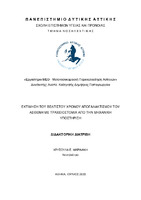| dc.contributor.advisor | Papageorgiou, Dimitrios | |
| dc.contributor.author | Μαρινάκη, Χρυσούλα | |
| dc.date.accessioned | 2023-07-12T08:12:50Z | |
| dc.date.available | 2023-07-12T08:12:50Z | |
| dc.date.issued | 2023-06-28 | |
| dc.identifier.uri | https://polynoe.lib.uniwa.gr/xmlui/handle/11400/4636 | |
| dc.identifier.uri | http://dx.doi.org/10.26265/polynoe-4474 | |
| dc.description.abstract | Εισαγωγή: Ο απογαλακτισμός και η τραχειοστομία είναι δύο διαφορετικές, αλλά ουσιαστικές και καθολικές διαδικασίες στη φροντίδα των ασθενών που λαμβάνουν μηχανικό αερισμό. Ο προσδιορισμός του χρονικού διαστήματος που απαιτείται για τον απογαλακτισμό, καθώς και οι παράγοντες που τον επηρεάζουν μπορούν να αξιοποιηθούν για τον κατάλληλο προγραμματισμό της ιατρονοσηλευτικής φροντίδας του ασθενή.
Σκοπός: Η εκτίμηση του βέλτιστου χρόνου απογαλακτισμού του ασθενή που νοσηλεύεται σε Μονάδα Εντατικής Θεραπείας με τραχειοστομία και μηχανική υποστήριξη.
Μέθοδος: Για το θεωρητικό μέρος, η αναζήτηση και η συλλογή της σχετικής βιβλιογραφίας πραγματοποιήθηκε μέσω των ηλεκτρονικών βάσεων δεδομένων υγείας: MEDLINE, CINAHL, Cochrane και PubMed. Το δείγμα της μελέτης αποτέλεσαν 162 ασθενείς από δύο ΜΕΘ δημοσίων νοσοκομείων. Για τη διεξαγωγή της μελέτης δημιουργήθηκε μια ειδικά διαμορφωμένη φόρμα καταγραφής. Σχετικά κλινικά δεδομένα εξήχθησαν ανώνυμα από τα ιατρικά αρχεία των ασθενών. Πριν από την έναρξη της μελέτης, οι συγγενείς των ασθενών κλήθηκαν να υπογράψουν το έντυπο συγκατάθεσης. Το ιατρικό ιστορικό, τα δημογραφικά και κλινικά χαρακτηριστικά των τραχειοτομημένων ασθενών αναλύθηκαν μέσω περιγραφικών στατιστικών. Για την καταγραφή και την ανάλυση των δεδομένων χρησιμοποιήθηκε το στατιστικό πακέτο SPSS v.25 για windows. Ως επίπεδο στατιστικής σημαντικότητας ορίστηκε το α=5%.
Αποτελέσματα: Το δείγμα της μελέτης αποτέλεσαν 162 ασθενείς από δύο ΜΕΘ δημοσίων νοσοκομείων. Μετά από σύγκριση και συσχέτιση των δημογραφικών και κλινικών χαρακτηριστικών και του ιατρικού ιστορικού των ασθενών με τη διάρκεια του απογαλακτισμού, τη διάρκεια παραμονής στη ΜΕΘ μετά από τραχειοστομία και το χρόνο μέχρι την τραχειοστομία αναδείχθηκαν ορισμένα αποτελέσματα. Πιο συγκεκριμένα αναδείχθηκαν διάφορες συσχετίσεις με την ηλικία, τον αριθμό προσπαθειών σύγκλισης, την επιτυχία σύγκλισης, το χρόνο μέχρι την τραχειοστομία, την παραμονή του ασθενή στη ΜΕΘ μετά από τραχειοστομία και την παρούσα νόσο, όπου φάνηκαν να επηρεάζουν την επιτυχία και τη διάρκεια του απογαλακτισμού.
Συμπεράσματα: Με βάση τα αποτελέσματα της παρούσας μελέτης συμπεραίνεται ότι η επιτυχία και η διάρκεια του απογαλακτισμού επηρεάζονται από ποικίλους παράγοντες. Όσο μικρότερο είναι το χρονικό διάστημα του απογαλακτισμού, τόσα περισσότερα είναι τα οφέλη για τον ίδιο τον ασθενή, όπως η αποφυγή βλάβης προκαλούμενης από τον αναπνευστήρα, η μείωση νοσηρότητας και θνησιμότητας και η μείωση παραμονής του ασθενή σε ΜΕΘ. Συνεπώς, ο βέλτιστος χρόνος απογαλακτισμού ενός ασθενή με τραχειοστομία είναι ο μικρότερος που μπορεί να επιτευχθεί. | el |
| dc.format.extent | 119 | el |
| dc.language.iso | el | el |
| dc.publisher | Πανεπιστήμιο Δυτικής Αττικής | el |
| dc.rights | Αναφορά Δημιουργού-Μη Εμπορική Χρήση-Όχι Παράγωγα Έργα 4.0 Διεθνές | * |
| dc.rights.uri | http://creativecommons.org/licenses/by-nc-nd/4.0/ | * |
| dc.subject | Τραχειοστομία | el |
| dc.subject | Απογαλακτισμός | el |
| dc.subject | Μηχανική υποστήριξη | el |
| dc.subject | Μονάδα εντατικής θεραπείας | el |
| dc.title | Εκτίμηση του βέλτιστου χρόνου απογαλακτισμού του ασθενή με τραχειοστομία από την μηχανική υποστήριξη | el |
| dc.title.alternative | Estimation of the optimal time needed for weaning of tracheostomized patients on mechanical ventilation | el |
| dc.type | Διδακτορική διατριβή | el |
| dc.contributor.committee | Κατσούλας, Θεόδωρος | |
| dc.contributor.committee | Kapadochos, Theodore | |
| dc.contributor.faculty | Σχολή Επιστημών Υγείας & Πρόνοιας | el |
| dc.contributor.department | Τμήμα Νοσηλευτικής | el |
| dc.description.abstracttranslated | Introduction: Weaning from mechanical ventilation and tracheostomy are two different but essential processes in the care of patients who receive mechanical ventilation. Determining the time that is required for weaning, as well as the factors that influence it can be used for the appropriate planning of the patient's medical and nursing care.
Aim: The aim of this study is to estimate the optimal time an Intensive Care Unit patient with tracheostomy needs to wean from mechanical ventilation.
Method: For the theoretical part, search and collection of relevant literature were carried out through the electronic health databases: MEDLINE, CINAHL, Cochrane and PubMed. This prospective observational study was conducted on 162 patients from two general hospitals in Athens, Greece. A specially designed recording form was created to conduct the study. Relevant clinical data were extracted from the patients’ health records, anonymised. Prior to the beginning of the study, the patients’ relatives were asked to sign an informed-consent form. Tracheostomised patients’ medical history, demographic and clinical characteristics were analysed through descriptive statistics. The Statistical Package for the Social Sciences (SPSS) v.25 for Windows was used to record and analyze the data. The level of statistical significance was set at α=5%.
Results: This study was conducted on 162 patients from two general hospitals. Some results occurred after comparisons and associations of demographic and clinical characteristics and medical history of patients with the duration of weaning, the length of stay in ICU after tracheostomy and the time from intubation to tracheostomy. More specifically, there seems to be an association between duration of weaning and age, number of closure attempts, success of closure, time from intubation to tracheostomy, length of the patient's post-tracheostomy ICU stay and diagnosis upon admission. These factors may affect its success and the length of patients’ waiting time between intubation and weaning.
Conclusion: According to the results of our study, there are various factors that affect success and duration of weaning. The shorter the duration of weaning, the greater the benefits for the patients themselves, such us avoiding respiratory damage, reduction of mortality and morbidity and reduction of length of patient’s ICU stay. The shorter the duration of weaning, the greater the benefits for the patients themselves are. | el |


